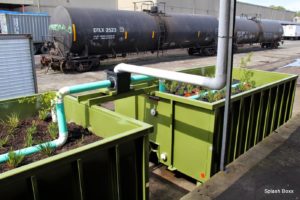Portable Bio Retention Planters at Port of Seattle
Case Study: Published | Updated: | | Seattle, Washington | 7666201530- Category
- category_listing(s)
- Building Type
- Infrastructure
- Innovation
- Portable Biorentention Planters
- Jurisdiction
- Seattle, Washington
- Parcel
- 7666201530
- Officials
- Paul Meyer | Port of Seattle
Doug Howie | Washington Department of Ecology - Team
-
David Hymel
|
Designer
Marilyn Jacobs | Designer
Amy Waterman | owner
Alessandra Zuin | owner
Hannah Kett | owner
Paul Meyer | owner
Douglas Howie | approving-official
Alice Lancaster | Other

The “Moving Green Infrastructure Forward” Project is a two-year stormwater monitoring project at Terminal 91, Port of Seattle. Using the Splash Boxx, a bioretention planter box used for stormwater management, the project compares the pollutant removal efficiency two bioretention soil mix designs: one with conventional sand/compost and another with volcanic sand/compost. Splash Boxx is recognized by the Washington Department of Ecology as equivalent to a bioretention facility, so the project was easily approved by the Port of Seattle. It was also designed consistent with City of Seattle guidelines for bioretention planter boxes.
Splash Boxx has been approved by the Department of Ecology as equivalent to bioretention systems as detailed in BMP T7.30, Bioretention Systems, 2012 Western Washington Stormwater Manual. This project was a retrofit installation, so a permit was not specifically required for this project; In a new construction installation, the Splash Boxx would be part of the stormwater treatment system subject to stormwater permit requirements from City of Seattle DPD (or other jurisdiction having authority).
| Code Requirement | Compliance Path |
|---|---|
| BMP T7.30, Bioretention Systems, 2012 Western Washington Stormwater Manual (see Vol. V, Ch. 7, pg 3 – pg 873 of the document). | Portable bioretention planters are approved by the Department of Ecology as equivalent to a bioretention system. Their Decision Letter. |
| Seattle would have approved based upon WA Department of Ecology Ruling, but a permit was not required in this case. Seattle provides a Permitting Tip Sheet on permitting of bioretention planters to guide such permitting. |